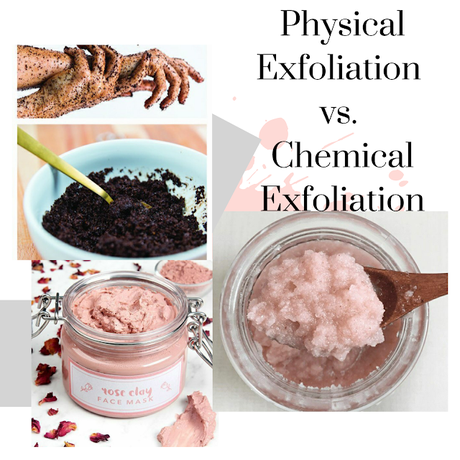
Physical Exfoliation vs. Chemical Exfoliation
Exfoliation is the way of removing the dead skin build over time. According to researchers, the life cycle of a cell is about 3 months in kids and about 30-50 days in adults. Our cells die a lot faster as we age. If you haven’t started incorporating exfoliation in your beauty routine yet, I am sure you must be missing that glow. Exfoliation not only helps to sweep away dead skin cells, but also removes grime, pollution, and makeup residue and gives you the instant benefit of deep-cleaning your pores to make your skin look brighter and feel softer. The cell cycle as mentioned above, leads to dead skin build-up, and if not exfoliated on a regular basis, will result in clogged pores, dull-looking skin, rough texture, etc. now, many of us do know about Physical exfoliation which is using some granulated product and rubbing the same on the skin to remove those dead cells. But do you know there is something like Chemical exfoliation too? If you are new to this exfoliation game, this post gonna help you out.
Physical Exfoliation and Chemical Exfoliation: what are they?
Physical exfoliation is the most common type which many of you must be familiar with. Physical exfoliation is using something abrasive on the skin which will eventually help remove the dead skin build-up. There are a number of brands that have their physical exfoliators in the market, some are with soap-free formulations as well, which is best suited for dry skin. Now the point which is to be kept in mind is that physical exfoliators shouldn’t be too harsh on the skin as in that case it might lead to more bad than good. So if you are into physical exfoliation, get hold of a scrubber which has mild exfoliating beads, and that too preferably which gets dissolved on the application after 1-2 minutes of scrubbing.Now, Chemical exfoliation, I know it might sound very acidic, right? Chemical exfoliators are actually composed of weak acids, like salicylic acid and glycolic acid, to give your skin a mild exfoliation. The two major variants of chemical exfoliators are Alpha Hydroxy Acids (AHAs) and Beta Hydroxy Acids (BHAs). AHAs are derivatives of natural substances and are ideal for dry skin as they remove the “glue” that holds dead skin cells together. AHAs melt that “glue” which attaches the dead skin cells to the outer layer of the skin and helps remove it. On the other hand, BHAs are oil-soluble ingredients that go deeper into the skin and pores for a thorough cleanse. BHAs also have anti-inflammatory and antibacterial properties as compared to AHAs. The two most popular AHAs are glycolic acid and lactic acid while BHA usually refers specifically to salicylic acid. AHAs are suitable for dry, dehydrated skin and those with signs of aging while BHAs are suitable for oil or combination r acne-prone skin types. Chemical exfoliating should be done post-cleansing three times a week or less, depending upon the product instructions and of course, the sensitivity of your skin.Now, whether you choose a physical or chemical exfoliation, both of it will help your skin regain that glow. But deciding variant is best for you depends on your skin type and concerns. If you’re looking for a product that deep cleanses as well as targets acne, or if your skin is damaged by the over-exposure of sun, a chemical exfoliant is a better choice for you. But in case if you have problem-free skin, go for physical exfoliation, listen to your skin and decide!

